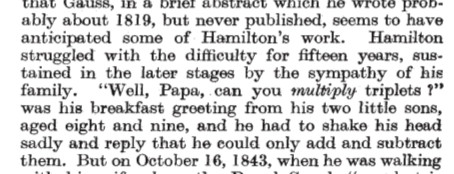There's a beautiful sort of geometry underlying all this that is known as symplectic structure. It's a rich field of mathematics. This formulation of classical mechanics was central to early formulations of quantum mechanics. (10/n)
Around the same time, Hamilton read a paper that treated complex numbers as pairs of real numbers, or "algebraic couples."
He was intrigued, and for years considered ways of using and extending these quantities in his study of mechanics, optics, and other fields. (11/n)
Replies
-
It was worth it! 🤣👍😎
-
Eventually he became fixated on the idea of endowing triplets of numbers with a similar structure to that of complex numbers. But he was stuck, and it was agony. Each morning, at breakfast, his children would ask "Well, Papa can you multiply triplets?" (12/n)
Ref: Piaggio, Nature 152, 1943
